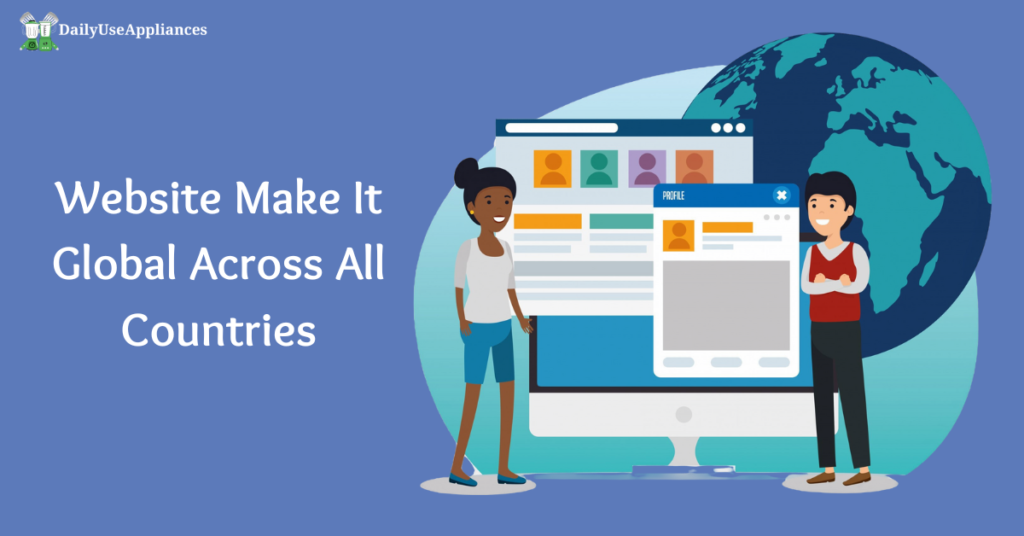In today’s interconnected world, businesses can no longer afford to stay local. If you’ve been wondering how to “website make it global across all countries,” this comprehensive guide will walk you through every step. Going global with your website opens doors to diverse audiences, amplifies your reach, and increases revenue opportunities. Let’s delve into how to make your website truly global.
Why Going Global is Essential for Your Website
Expanding your website’s reach across countries isn’t just a good idea; it’s a necessity. Here’s why:
- Broaden Your Audience: Tapping into global markets increases your potential customer base exponentially.
- Revenue Growth: More reach means more opportunities for conversions and revenue generation.
- Competitive Advantage: A global presence keeps you ahead of competitors who remain confined to local markets.
If you want your website to succeed on a global scale, it’s crucial to adapt to the diverse needs of international users.
Know More >> Mega-Personal.net Health Archives: An Exhaustive Guide
Understanding Your Target Audience
Identifying Global Markets
The first step to making your website global is identifying the countries you want to target. Use tools like Google Analytics to analyze traffic and see which regions have potential.
Analyzing User Behavior Across Regions
User behavior varies widely across cultures. For example, some countries prefer mobile browsing, while others lean toward desktop usage. Study regional preferences to cater to these nuances effectively.
Creating Multilingual and Multiregional Websites
Importance of Multilingual Content
A global audience speaks different languages. Offering multilingual content ensures that your website resonates with users worldwide. Remember, a user is more likely to stay on your site if they understand the content.
Differences Between Multilingual and Multiregional Approaches
- Multilingual Websites: Translate content into various languages.
- Multiregional Websites: Tailor content to the specific needs of different countries or regions. For instance, your UK and US websites might share a language but differ in pricing and cultural references.
SEO Strategies for a Website Make It Global Across All Countries
Utilizing Hreflang Tags
Hreflang tags are essential for global websites. They signal to search engines which language version of a page to show to users based on their location.
Keyword Research for Different Languages
When optimizing your website to “website make it global across all countries,” remember that keywords vary across languages and regions. Research what your audience is searching for in their native language.
Optimizing for Local Search Engines
Google may dominate, but don’t overlook local search engines like Baidu (China) or Yandex (Russia). Tailor your SEO efforts to these platforms for better reach.
Localization vs. Translation
Why Localization Matters
Translation converts text from one language to another, but localization goes further. It adapts content to cultural nuances, idioms, and user expectations, making your website feel native to international users.
Examples of Effective Localization
Consider how Netflix tailors its recommendations and subtitles to each country. This approach creates a sense of familiarity and builds trust with users.
Mobile-Friendly and Responsive Design
Importance of Mobile Accessibility
Mobile devices account for over half of global internet traffic. Ensure your website performs seamlessly on smartphones and tablets.
Ensuring Responsive Design for All Devices
Responsive design ensures that your site’s layout adjusts perfectly to any screen size, offering a consistent user experience across devices.
Technical Infrastructure for a Website Make It Global Across All Countries
Choosing the Right Hosting Providers
Hosting impacts your website’s speed and reliability. Use local servers or international providers with a global network to reduce latency.
Using CDNs for Faster Loading Times
Content Delivery Networks (CDNs) distribute your site’s content across global servers, ensuring faster loading speeds for international users.
Payment and Currency Options
Offering Multiple Payment Gateways
Support payment methods that are popular in different countries. For example, Alipay in China or UPI in India.
Supporting Local Currencies
Displaying prices in local currencies simplifies the buying process and builds trust with customers.
Complying with International Laws
Understanding GDPR and Similar Regulations
When aiming to “website make it global across all countries,” compliance with laws like GDPR (Europe) or CCPA (California) is non-negotiable. These laws govern user privacy and data security.
Privacy Policies and Cookie Notices for Global Users
Craft clear and concise privacy policies tailored to each region’s legal requirements.
Ensuring Accessibility Standards
Why Accessibility Matters
Accessibility ensures everyone, including users with disabilities, can interact with your website. It’s also a legal requirement in many countries.
Implementing Global Accessibility Standards
Follow the Web Content Accessibility Guidelines (WCAG) to make your website universally accessible.
Building Trust with a Global Audience
Displaying Social Proof and Reviews
Showcase testimonials, ratings, and reviews from different regions to build credibility.
Providing Excellent Customer Support in Multiple Languages
Invest in multilingual customer service to cater to your global audience effectively.
Leveraging Social Media for Global Reach
How Social Media Supports Global Expansion
Social media platforms help you connect with users across borders. Tailor your content to suit regional preferences and cultural norms.
Choosing the Right Platforms for Each Region
Use region-specific platforms like WeChat in China or VKontakte in Russia to maximize your reach.
Analytics and Performance Monitoring
Tracking Metrics for Different Regions
Track region-specific performance metrics like bounce rates, conversions, and traffic sources.
Tools for Monitoring Global Performance
Utilize tools like Google Analytics, SEMrush, or Ahrefs to gain insights and optimize your website’s global performance.
Read More >> Skip Marsh Plastisol Ink: A Complete Guide for Screen Printing Professionals
Overcoming Challenges in Going Global
Common Challenges of Global Websites
Cultural differences, language barriers, and technical constraints are common hurdles.
Solutions to Address These Challenges
- Invest in professional localization services.
- Use tools to streamline translation and content management.
- Educate your team about global cultural norms.
Conclusion
Making your “website make it global across all countries” isn’t just about adding languages or expanding hosting. It’s a strategic process involving localization, technical optimization, and understanding user behavior. By following these steps, you can build a website that resonates with audiences worldwide, ensuring success across borders.
FAQs
1. How do I decide which languages to include on my website?
Research your audience demographics and prioritize languages with the highest demand.
2. What are Hreflang tags, and why are they important?
Hreflang tags help search engines serve the correct version of your site based on user location and language.
3. How can I ensure my website complies with global privacy laws?
Consult legal experts and provide clear, region-specific privacy policies.
4. What is the difference between localization and translation?
Translation changes the language, while localization adapts content to fit cultural norms and preferences.5. How do I measure the success of a global website?
Use analytics tools to monitor traffic, engagement, and conversions for each region.









